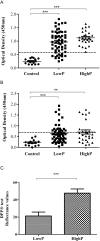Parasite load induces progressive spleen architecture breakage and impairs cytokine mRNA expression in Leishmania infantum-naturally infected dogs
- PMID: 25875101
- PMCID: PMC4395300
- DOI: 10.1371/journal.pone.0123009
Parasite load induces progressive spleen architecture breakage and impairs cytokine mRNA expression in Leishmania infantum-naturally infected dogs
Abstract
Canine Visceral Leishmaniasis (CVL) shares many aspects with the human disease and dogs are considered the main urban reservoir of L. infantum in zoonotic VL. Infected dogs develop progressive disease with a large clinical spectrum. A complex balance between the parasite and the genetic/immunological background of the host are decisive for infection evolution and clinical outcome. This study comprised 92 Leishmania infected mongrel dogs of various ages from Mato Grosso, Brazil. Spleen samples were collected for determining parasite load, humoral response, cytokine mRNA expression and histopathology alterations. By real-time PCR for the ssrRNA Leishmania gene, two groups were defined; a low (lowP, n = 46) and a high parasite load groups (highP, n = 42). When comparing these groups, results show variable individual humoral immune response with higher specific IgG production in infected animals but with a notable difference in CVL rapid test optical densities (DPP) between highP and lowP groups. Splenic architecture disruption was characterized by disorganization of white pulp, more evident in animals with high parasitism. All cytokine transcripts in spleen were less expressed in highP than lowP groups with a large heterogeneous variation in response. Individual correlation analysis between cytokine expression and parasite load revealed a negative correlation for both pro-inflammatory cytokines: IFNγ, IL-12, IL-6; and anti-inflammatory cytokines: IL-10 and TGFβ. TNF showed the best negative correlation (r2 = 0.231; p<0.001). Herein we describe impairment on mRNA cytokine expression in leishmania infected dogs with high parasite load associated with a structural modification in the splenic lymphoid micro-architecture. We also discuss the possible mechanism responsible for the uncontrolled parasite growth and clinical outcome.
Conflict of interest statement
Figures







Similar articles
-
Pro-Cellular Exhaustion Markers are Associated with Splenic Microarchitecture Disorganization and Parasite Load in Dogs with Visceral Leishmaniasis.Sci Rep. 2019 Sep 10;9(1):12962. doi: 10.1038/s41598-019-49344-1. Sci Rep. 2019. PMID: 31506501 Free PMC article.
-
Splenic macrophage functional profile and its role in the immunopathogenesis of canine visceral leishmaniasis.Front Immunol. 2025 Jun 20;16:1617751. doi: 10.3389/fimmu.2025.1617751. eCollection 2025. Front Immunol. 2025. PMID: 40621456 Free PMC article.
-
Association of pro-inflammatory cytokines and iron regulatory protein 2 (IRP2) with Leishmania burden in canine visceral leishmaniasis.PLoS One. 2013 Oct 11;8(10):e73873. doi: 10.1371/journal.pone.0073873. eCollection 2013. PLoS One. 2013. PMID: 24146743 Free PMC article.
-
Systemic and compartmentalized immune response in canine visceral leishmaniasis.Vet Immunol Immunopathol. 2009 Mar 15;128(1-3):87-95. doi: 10.1016/j.vetimm.2008.10.307. Epub 2008 Oct 17. Vet Immunol Immunopathol. 2009. PMID: 19054576 Review.
-
Cutaneous immune mechanisms in canine leishmaniosis due to Leishmania infantum.Vet Immunol Immunopathol. 2015 Feb 15;163(3-4):94-102. doi: 10.1016/j.vetimm.2014.11.011. Epub 2014 Nov 20. Vet Immunol Immunopathol. 2015. PMID: 25555497 Review.
Cited by
-
Disruption of Splenic Lymphoid Tissue and Plasmacytosis in Canine Visceral Leishmaniasis: Changes in Homing and Survival of Plasma Cells.PLoS One. 2016 May 31;11(5):e0156733. doi: 10.1371/journal.pone.0156733. eCollection 2016. PLoS One. 2016. PMID: 27243459 Free PMC article.
-
The outcomes of polyparasitism in stray cats from Brazilian Midwest assessed by epidemiological, hematological and pathological data.Rev Bras Parasitol Vet. 2022 Jul 4;31(2):e004222. doi: 10.1590/S1984-29612022033. eCollection 2022. Rev Bras Parasitol Vet. 2022. PMID: 35792756 Free PMC article.
-
LBMPL Vaccine Therapy Induces Progressive Organization of the Spleen Microarchitecture, Improved Th1 Adaptative Immune Response and Control of Parasitism in Leishmania infantum Naturally Infected Dogs.Pathogens. 2022 Aug 26;11(9):974. doi: 10.3390/pathogens11090974. Pathogens. 2022. PMID: 36145406 Free PMC article.
-
Immunization against Leishmania major infection in BALB/c mice using a subunit-based DNA vaccine derived from TSA, LmSTI1, KMP11, and LACK predominant antigens.Iran J Basic Med Sci. 2019 Dec;22(12):1493-1501. doi: 10.22038/IJBMS.2019.14051. Iran J Basic Med Sci. 2019. PMID: 32133069 Free PMC article.
-
Molecular detection of vector-borne pathogens in blood and splenic samples from dogs with splenic disease.Parasit Vectors. 2017 Mar 13;10(1):131. doi: 10.1186/s13071-017-2074-z. Parasit Vectors. 2017. PMID: 28285583 Free PMC article.
References
-
- Moreno J, Alvar J (2002) Canine leishmaniasis: epidemiological risk and the experimental model. Trends in Parasitology 18 399–405. - PubMed
-
- WHO (2010) Control of the leishmaniases Geneva: WHO Expert Committee on the Control of Leishmaniases.
-
- Palatnik-De-Sousa CB, Dos Santos WR, FrançA-Silva JC, Da Costa RT, Reis AB, Palatnik M, et al. (2001) Impact of canine control on the epidemiology of canine and human visceral Leishmaniasis in Brazil. The American journal of tropical medicine and hygiene 65: 510–517. - PubMed
-
- Courtenay O, Quinnell R-J, Garcez L-M, Shaw J-J, Dye C (2002) Infectiousness in a Cohort of Brazilian Dogs: Why Culling Fails to Control Visceral Leishmaniasis in Areas of High Transmission. The Journal of Infectious Diseases 186: 1314–1320. - PubMed
Publication types
MeSH terms
Substances
LinkOut - more resources
Full Text Sources
Other Literature Sources

